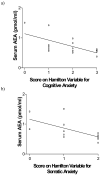Serum endocannabinoid content is altered in females with depressive disorders: a preliminary report
- PMID: 18311684
- PMCID: PMC3422568
- DOI: 10.1055/s-2007-993211
Serum endocannabinoid content is altered in females with depressive disorders: a preliminary report
Abstract
Background: Preclinical research has suggested that the endocannabinoid system may be involved in the etiology and/or treatment of depression; however, there are no published studies examining circulating endocannabinoid content in patients with clinical depression.
Methods: This study examined the endocannabinoids (anandamide; AEA) and 2-arachidonylglycerol (2-AG) in serum from ambulatory, medication-free female patients diagnosed with minor or major depression, and in controls matched for demographic characteristics.
Results: Serum 2-AG content was significantly decreased in patients diagnosed with major depression, and this decrease was correlated significantly and negatively with duration of the depressive episode, such that 2-AG content was progressively lower the longer the depressive episode. While AEA was not associated with major depression PER SE, a strong negative correlation was found between serum AEA content and Hamilton ratings for cognitive and somatic anxiety, suggesting that AEA content may relate to the anxiety dimension of affective disorders. In subjects with minor depression, serum AEA was significantly elevated, with 2-AG content demonstrating a similar, but statistically insignificant trend.
Discussion: These are the first clinical data to indicate that the endocannabinoid system may be disturbed in affective disease, and suggest that future research is required to determine the relevance of these changes with respect to disease manifestation and pharmacotherapy.
Figures



References
-
- American Psychiatric Association . Diagnostic and statistical manual of mental disorders. 4th ed. American Psychiatric Association; Washington DC: 1994.
-
- Barna I, Zelena D, Arszovszki AC, Ledent C. The role of endogenous cannabinoids in the hypothalamo-pituitary-adrenal axis regulation: in vivo and in vitro studies in CB1 receptor knockout mice. Life Sci. 2004;75:2959–2970. - PubMed
-
- Freedland KE, Skala JA, Carney RM, Raczynski JM, Taylor CB, Mendes de Leon CF. The Depression Interview and Structured Hamilton (DISH): rationale, development, characteristics, and clinical validity. Psychosom Med. 2002;64:897–905. - PubMed
-
- Gaetani S, Cuomo V, Piomelli D. Anandamide hydrolysis: a new target for anti-anxiety drugs? Trends Mol Med. 2003;9:474–478. - PubMed
Publication types
MeSH terms
Substances
Grants and funding
LinkOut - more resources
Full Text Sources
Other Literature Sources
Medical

